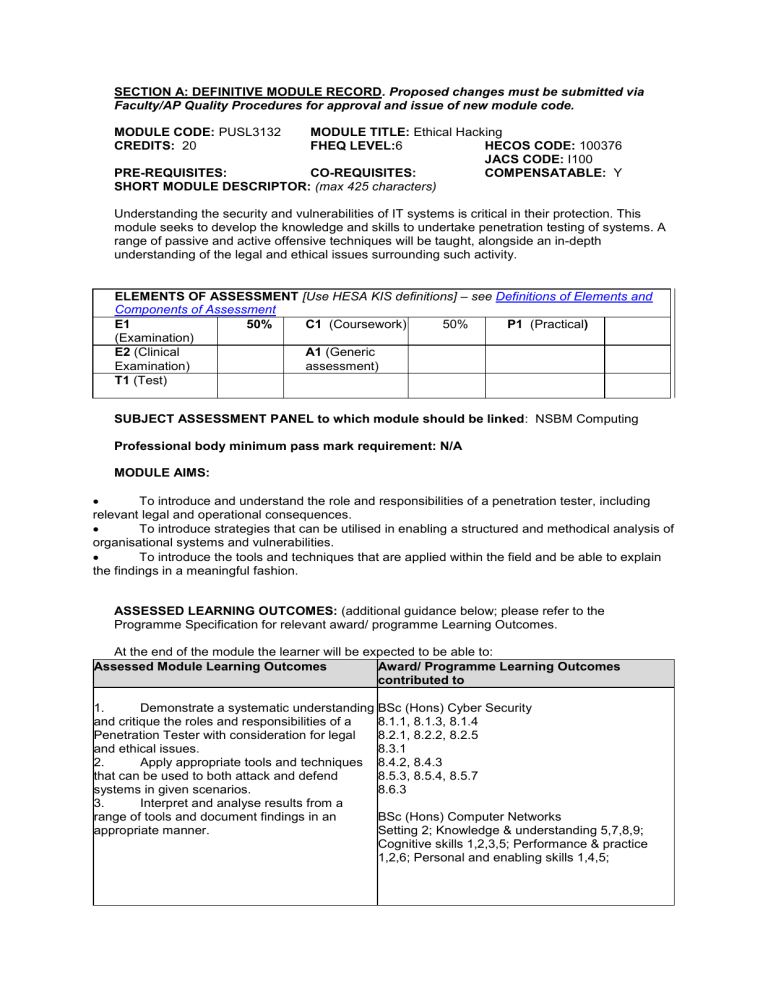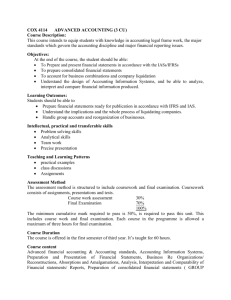
SECTION A: DEFINITIVE MODULE RECORD. Proposed changes must be submitted via Faculty/AP Quality Procedures for approval and issue of new module code. MODULE CODE: PUSL3132 CREDITS: 20 MODULE TITLE: Ethical Hacking FHEQ LEVEL:6 HECOS CODE: 100376 JACS CODE: I100 PRE-REQUISITES: CO-REQUISITES: COMPENSATABLE: Y SHORT MODULE DESCRIPTOR: (max 425 characters) Understanding the security and vulnerabilities of IT systems is critical in their protection. This module seeks to develop the knowledge and skills to undertake penetration testing of systems. A range of passive and active offensive techniques will be taught, alongside an in-depth understanding of the legal and ethical issues surrounding such activity. ELEMENTS OF ASSESSMENT Components of Assessment E1 50% (Examination) E2 (Clinical Examination) T1 (Test) [Use HESA KIS definitions] – see Definitions of Elements and C1 (Coursework) 50% P1 (Practical) A1 (Generic assessment) SUBJECT ASSESSMENT PANEL to which module should be linked: NSBM Computing Professional body minimum pass mark requirement: N/A MODULE AIMS: To introduce and understand the role and responsibilities of a penetration tester, including relevant legal and operational consequences. To introduce strategies that can be utilised in enabling a structured and methodical analysis of organisational systems and vulnerabilities. To introduce the tools and techniques that are applied within the field and be able to explain the findings in a meaningful fashion. ASSESSED LEARNING OUTCOMES: (additional guidance below; please refer to the Programme Specification for relevant award/ programme Learning Outcomes. At the end of the module the learner will be expected to be able to: Assessed Module Learning Outcomes Award/ Programme Learning Outcomes contributed to 1. Demonstrate a systematic understanding BSc (Hons) Cyber Security and critique the roles and responsibilities of a 8.1.1, 8.1.3, 8.1.4 Penetration Tester with consideration for legal 8.2.1, 8.2.2, 8.2.5 and ethical issues. 8.3.1 2. Apply appropriate tools and techniques 8.4.2, 8.4.3 that can be used to both attack and defend 8.5.3, 8.5.4, 8.5.7 systems in given scenarios. 8.6.3 3. Interpret and analyse results from a range of tools and document findings in an BSc (Hons) Computer Networks appropriate manner. Setting 2; Knowledge & understanding 5,7,8,9; Cognitive skills 1,2,3,5; Performance & practice 1,2,6; Personal and enabling skills 1,4,5; DATE OF APPROVAL: July 21 DATE OF IMPLEMENTATION: 01/09/2022 DATE(S) OF APPROVED CHANGE: July 2023 Notes: FACULTY/OFFICE: Academic Partnerships SCHOOL/PARTNER: NSBM SEMESTER: Semester 2 Additional Guidance for Learning Outcomes: To ensure that the module is pitched at the right level check your intended learning outcomes against the following nationally agreed standards Framework for Higher Education Qualifications http://www.qaa.ac.uk/publications/information-andguidance/publication/?PubID=2718#.VW2INtJVikp Subject benchmark statements http://www.qaa.ac.uk/ASSURINGSTANDARDSANDQUALITY/SUBJECTGUIDANCE/Pages/Subject-benchmark-statements.aspx Professional, regulatory and statutory (PSRB) accreditation requirements (where necessary e.g. health and social care, medicine, engineering, psychology, architecture, teaching, law) QAA Quality Code http://www.qaa.ac.uk/AssuringStandardsAndQuality/qualitycode/Pages/default.aspx Page Break SECTION B: DETAILS OF TEACHING, LEARNING AND ASSESSMENT Items in this section must be considered annually and amended as appropriate, in conjunction with the Module Review Process. Some parts of this page may be used in the KIS return and published on the extranet as a guide for prospective students. Further details for current students should be provided in module guidance notes. ACADEMIC YEAR: 2022/23 MODULE LEADER: TBC NATIONAL COST CENTRE:121 OTHER MODULE STAFF: TBC Summary of Module Content The module will consider the principles of Penetration Testing (roles, responsibilities, legal, ethical, etc.); tools and techniques for undertaking a Penetration Test (footprinting / reconnaissance / scanning / access / exploitation techniques etc.); and, the documentation of findings. The module also considers a range of protective mechanisms that can be deployed to protect or mitigate such attacks. Indicative topics: Legal/ethical context, footprinting, scanning, enumeration, sniffing, social engineering, application level attacks, wireless networks, firewalls, network access control, traffic auditing, exfiltration techniques, anonymisation. SUMMARY OF TEACHING AND LEARNING [Use HESA KIS definitions] Scheduled Hours Comments/Additional Information (briefly explain Activities activities, including formative assessment opportunities) Lectures 24 To deliver the core body of knowledge Labs 24 Assessment 4 Self-Study 148 Total 200 Practical based activities to reinforce knowledge introduced in lectures Formative and summative assessment opportunities An opportunity to read around the subject, to obtain greater depth of understanding of the subject. (NB: 1 credit = 10 hours of learning; 10 credits = 100 hours, etc.) SUMMATIVE ASSESSMENT Element Category Component Name Component Weighting E1 (Examination) Written exam 100% Test % % 100% C1 - Assignment Coursework 100% Practical % % 100% Clinical Examination % % 100% Generic Assessment Pass/Fail REFERRAL ASSESSMENT Element Category Written exam Component Name Component Weighting % % 100% Coursework (in lieu of the original assessment) E1 – Coursework in lieu of referred exam 100% C1 - Referral Assignment Coursework 100% Practical % % 100% Clinical Examination % % 100% Generic Assessment Test Pass/Fail % % 100% To be completed when presented for Minor Change approval and/or annually updated Updated by: R Approved by: Stuhlmeier Date: 1/7/2021 Date: XX/XX/XXXX



